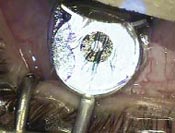Flap holder allows LASIK re-treatments on underside of flap
The procedure avoids additional risk of developing keratectesia after secondary LASIK procedures.
|
|
ROME – A new device allows safe LASIK re-treatments on the undersurface of the flap in eyes that have a thin residual posterior stroma, according to a surgeon speaking here. The device is a simple flap holder with a ring-shaped mark that replaces the natural pupil for eye tracking during the procedure.
“Re-LASIK on the undersurface of the flap makes sense because the flap doesn’t contribute to the mechanical stability of the cornea. A thinner flap doesn’t increase the risk of keratectasia, contrary to what happens with a second ablation on the stromal bed, which makes the cornea weaker,” said Suphi Taneri, MD, at the European Society of Cataract and Refractive Surgeons Winter Refractive Surgery Meeting.
A retrospective analysis of post-LASIK ectasia cases showed that there is no precise safety threshold, Dr. Taneri said.
Consequently, provided that the flap has sufficient thickness for ablation, re-LASIK on its undersurface is safer and just as effective as stromal ablation, he said. Moreover, eyes that are not eligible for stromal enhancements because a thin stromal bed can be treated on the undersurface. Dr. Taneri pointed out that since the flap moves as much as the eye does, some form of tracking is mandatory, especially with modern flying-spot lasers.
“We created a flap holder with a ring-shaped mark in the center. Prior to surgery, we mark the center of the entrance pupil on the corneal epithelium, then lift the flap, reflecting it on top of the flap holder. The round mark of the flap holder, which does not need to precisely coincide with the pupil marking on the cornea, is visible in transparency, and the eye-tracker is locked on it during the ablation. While ablating the undersurface of the flap, the natural pupil should always be covered with a Merocel sponge to avoid confusing the eye-tracker,” Dr. Taneri explained. Undersurface ablation requires a flap that is not too thin. Dr. Taneri suggested a cutoff point of 80 µm for undersurface ablation.
|
|
|
For Your Information:
- Suphi Taneri, MD, can be reached at Zentrum für Refraktive Chirurgie, Hohenzollernklinik, Hohenzollernring 57, D-48145 Münster, Germany; +49-251-9877890; fax: +49-251-9877898 ; e-mail: taneri@refraktives-zentrum.de. Dr. Taneri has no direct financial interest in the products mentioned in this article, nor is he a paid consultant for any companies mentioned.
- Michela Cimberle is an OSN Correspondent based in Treviso, Italy.



